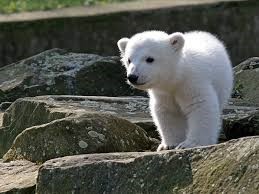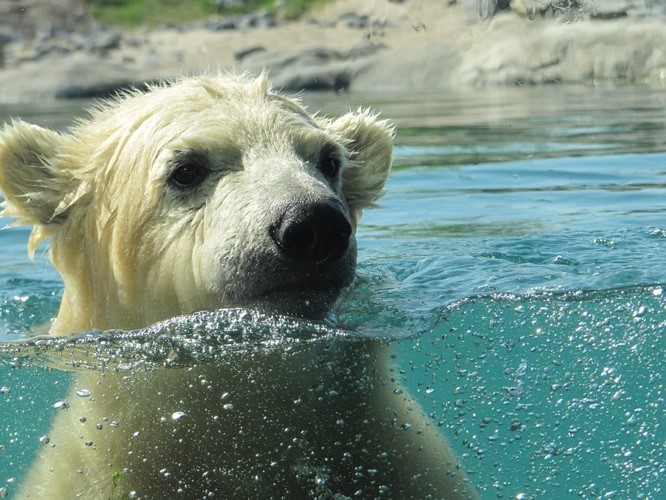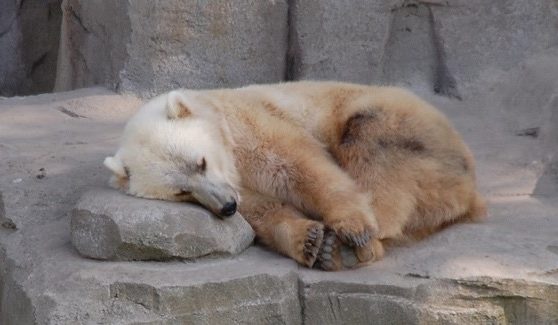
Lately, the United Nations Framework Convention on Climate Change took place in Bonn. Apparently, confrontation and reflection on our planet´s global warming evokes very different associations in each and every one of us. When the 23rd Conference of the Parties (COP 23) was held, I thought of the little polar bear cub named Lars because I fear that many years from now children could read about polar bears and the Netherlands among “The Land Before Time,” “Harry Potter,” and “The Chronicles of Narnia,” as if these had been invented by a novelist.
Lovely Lars
But who is Lars? Lars is the main character of the beloved children´s book “The Little Polar Bear,” which was written by the Dutch author Hans de Beer. Unfortunately, in the future polar bears and the Dutch could share the same fate by literally being in deep water. As the polar caps melt and the habitat of polar bears declines, the living environment of the Dutch does due to rising sea levels. Thus, added water from melting ice sheets and glaciers and the expansion of warming seawater pose a threat to polar bears as well as the Dutch. The reason for these developments: global warming.
Global warming – a polar bear´s nightmare
Why you should care? Because during the last 50 years the average global temperature increased at the fastest rate in recorded history. Frighteningly, evidence reveals that it took the planet about 5000 years to warm 5°C when global warming happened within the past two million years. However, current warming already occurs about ten times faster than the average rate of ice-age-recovery warming(1), which is why the rate of warming for the next century is estimated to be a lot faster than in the past. Moreover, the earth’s average surface temperature may rise another 2.6 to 4.8°C during the 21st century(2). Due to the increased carbon dioxide, methane, and nitrous oxide emission, the earth’s average surface temperature already rose about 1°C since the late 19th century. But this is not where it ends. Alarmingly, most of the warming was recorded in recent years. Not only was 2016 the warmest year on record, in fact 16 of the 17 warmest years on record occurred since 2001(3). As the oceans have absorbed much of the increased heat, the Antarctic ice sheets have decreased in mass and glaciers are retreating in the Alps, Andes, Rockies, and Himalayas(4), resulting in a global sea level rise.
The Netherlands – where Lars was born
Since the Netherlands is the homeland of Lars´  creator, metaphorically he was born there. Owing to global warming, in the near future the Netherlands will not solely be famous for cheese, wooden shoes, and windmills. As one of the most densely populated countries on earth, more than half of the country lie at or below sea level with 60% of the country being vulnerable to flooding. Factual, the Netherlands are surrounded and lanced by water since the North Sea is found at its shore and immense rivers flow through the country, coming from Belgium, France, and Germany, pervading the country. Therefore, the Dutch are experts in water management and inspired a The Guardian reporter to dub “The Dutch solution to floods: live with water, don’t fight it” in 2014(5). Because of the feared rise in sea level, the “Room for the River” project was founded, referred to by The New York Times as “Going With the Flow”(6). The principle of “Room for the Rivers” basically is to let water in wherever this is possible. For this purpose the Dutch devise lakes, garages, parks and plazas as huge water reservoirs for when the seas and rivers spill over, as reported by The New York Times earlier this year(7). Albeit it may take a long time until the Netherlands will be lost to the sea, recent developments are nevertheless alarming. Furthermore, challenges like these give us a foretaste of the changes and compromises future generations will need to live with if we do not take action now.
creator, metaphorically he was born there. Owing to global warming, in the near future the Netherlands will not solely be famous for cheese, wooden shoes, and windmills. As one of the most densely populated countries on earth, more than half of the country lie at or below sea level with 60% of the country being vulnerable to flooding. Factual, the Netherlands are surrounded and lanced by water since the North Sea is found at its shore and immense rivers flow through the country, coming from Belgium, France, and Germany, pervading the country. Therefore, the Dutch are experts in water management and inspired a The Guardian reporter to dub “The Dutch solution to floods: live with water, don’t fight it” in 2014(5). Because of the feared rise in sea level, the “Room for the River” project was founded, referred to by The New York Times as “Going With the Flow”(6). The principle of “Room for the Rivers” basically is to let water in wherever this is possible. For this purpose the Dutch devise lakes, garages, parks and plazas as huge water reservoirs for when the seas and rivers spill over, as reported by The New York Times earlier this year(7). Albeit it may take a long time until the Netherlands will be lost to the sea, recent developments are nevertheless alarming. Furthermore, challenges like these give us a foretaste of the changes and compromises future generations will need to live with if we do not take action now.
The Arctic – where Lars and his relatives live
Polar bears (Ursus maritimus) are marine mammals, which spend most of their lives on sea ice of the Arctic Ocean. Although they sit at the top of the food chain in their habitat, the World Conservation Union (IUCN) estimates that only 20.000-25.000 agile polar bears live distributed across 19 subpopulations. Polar bears feed almost exclusively on ringed seals since they need the large amounts of fat they provide. These seals can be found on continually melting and re-freezing matrices of ice patches. Thus, the polar bears´ life cycles are intimately linked to sea ice. According to research many polar bears will starve if the ice-free season gets too long in much of the Arctic. “Basically, you can write off most of the southern populations,” says Andrew Derocher, a biologist at the University of Alberta in Edmonton, Canada(8). Since climate change unfortunately accelerates the decline of the polar bears´ sea ice habitat, a research team in Norway investigated whether the spatial overlap between polar bears and ringed seals has been affected by the decline in sea ice observed in Norway in 2006. Their results indicate that sea ice declines have impacted the strength of the predator-prey relationship between polar bears and ringed seals, leading to consequences for the wider Arctic marine and terrestrial ecosystems(9).
Polar bears – some don´t like it hot
In 2008 polar bears were listed as ‘threatened’ throughout their range under the US Endangered Species Act. Further, data from the IUCN Polar Bear Specialist Group show that three of the 19 polar bear subpopulations are declining and that a future decline due to climate change is highly likely(10). According to alarming observations, autumn last year the cap of sea ice covering the Arctic Ocean shrank rather than grew and temperatures at the North Pole soared more than 20°C above normal(8). Researchers say that as early as 2030, the Arctic Ocean could lose essentially all of its ice during the warmest months of the year. Since models have consistently underestimated ice losses in the past, scientists worry that sea ice declines in the next decades will outpace current projections(8). In Western Hudson Bay (Canada), the polar bear population has already shown a slow decline due to shorter sea-ice duration in the past(11). Further, predictions of scientists trying to assess the future of polar bears in Western Hudson Bay describe the years occurring mostly after 2050 as critical. Importantly, although Arctic marine mammals are well adapted to fluctuating environments, analyses show that rapid ice loss could trigger strong non-linear declines in survival(12). On the bright side, it was reported that reducing greenhouse gases emissions could allow polar bears to persist in Western Hudson Bay throughout the 21st century(13). Moreover, Amstrup and colleagues examined projection models of sea-ice loss based on different greenhouse gas emission scenarios and found that mitigation could greatly improve the conservation status of polar bears into the next century. They further confirm earlier findings that emission scenarios with high end-of-century levels of carbon dioxide will result in huge polar bears loss(14). But this is not the only reason for concern of polar bear researchers. While the friendship of the polar bear cub Lars with his friend Brownie Brown Bear is totally cute on screen, more than friendship between individuals of different species does not occur in nature, or does it?
Future bears – polar, grizzly, pizzly, or grolar?
Meet the new bear:  The time has come to welcome the “pizzly bear“, or “grolar bear“. And no, these bears have not been invented by a novelist. Both names describe a grizzly-polar bear hybrid, whose increase we should thank climate change for. From observations in zoos it was already known that mating of both species occurs and produces fertile offspring. This is possible due to the close relatedness of both bear species. According to researcher Eline Lorenzen from the University of Copenhagen (Denmark), polar and grizzly bears first diverged as a species between 479.000 and 343.000 years ago and have met and interbred repeatedly since then(15). But why do polar bears and grizzly bears mate? And why does this happen more often than in the past? The answer is quite simple. As the warming environment of grizzly bears in Canada and Alaska forces them north, they get in closer contact to polar bears that are – due to ice loss – obliged to go on land during mating season. As the grizzly bear expert Chris Servheen told The Guardian, it is the combination of warmer temperatures and vegetation growth that increases the overlap between grizzly and polar bears – an overlap that is expected to increase further(16). The concern of the researchers Derocher and Lorenzen is the dominance of grizzly bear DNA. They assume that in the end one species will be integrated into the other. From their point of view, it is likely that the polar bear DNA will integrate into the grizzly bear´s DNA. Although they agree that it may take hundreds of thousands of years for a new species to arise, these will nevertheless be changes with consequences.
The time has come to welcome the “pizzly bear“, or “grolar bear“. And no, these bears have not been invented by a novelist. Both names describe a grizzly-polar bear hybrid, whose increase we should thank climate change for. From observations in zoos it was already known that mating of both species occurs and produces fertile offspring. This is possible due to the close relatedness of both bear species. According to researcher Eline Lorenzen from the University of Copenhagen (Denmark), polar and grizzly bears first diverged as a species between 479.000 and 343.000 years ago and have met and interbred repeatedly since then(15). But why do polar bears and grizzly bears mate? And why does this happen more often than in the past? The answer is quite simple. As the warming environment of grizzly bears in Canada and Alaska forces them north, they get in closer contact to polar bears that are – due to ice loss – obliged to go on land during mating season. As the grizzly bear expert Chris Servheen told The Guardian, it is the combination of warmer temperatures and vegetation growth that increases the overlap between grizzly and polar bears – an overlap that is expected to increase further(16). The concern of the researchers Derocher and Lorenzen is the dominance of grizzly bear DNA. They assume that in the end one species will be integrated into the other. From their point of view, it is likely that the polar bear DNA will integrate into the grizzly bear´s DNA. Although they agree that it may take hundreds of thousands of years for a new species to arise, these will nevertheless be changes with consequences.
Progressing scepticism versus cautious optimism
Globally, about 25% of all mammalian species are threatened by extinction, mainly provoked by habitat loss and degradation(17). Thus, the polar bears´ state of emergency sadly is no exception. Interestingly, if countries fulfill their commitments to the Paris climate agreement, global climate models suggest that about 3 million square kilometers of ice, which represents about half of the minimum summer coverage in recent decades, could be maintained(8). Hence, the future of the Arctic seems dire, but there is reason for optimism since the process of global warming is not irreversible and summer sea ice will return whenever the planet cools down again. “You could bring it back even if you lose it all,” as Julienne Stroeve, a sea-ice researcher at University College London, predicts(8).
Lars – the last
As a journalist of The Times of Israel wrote in his article “The Netherlands Will Disappear Under Water”(18) earlier this year, “I have no idea what the future will look like but boredom doesn’t seem on the menu.” No doubt, there is a lot we do not know today and current developments do not make it easy to predict future evolution and tipping points. However, as researcher Derocher summarizes “there is cause for optimism, but that requires optimism about our ability to change.”(19) Do we want Lars to be the last polar bear soon? If not, now is the time to take action and engage in the future we are responsible for because if there is something we do know for sure, it is that if we do not change our attitude towards our planet, we most certainly approach the end of an era, saying goodbye to the polar bears and the Netherlands as we know them. Then, soon only lonely little Lars will remain and remind us.
article “The Netherlands Will Disappear Under Water”(18) earlier this year, “I have no idea what the future will look like but boredom doesn’t seem on the menu.” No doubt, there is a lot we do not know today and current developments do not make it easy to predict future evolution and tipping points. However, as researcher Derocher summarizes “there is cause for optimism, but that requires optimism about our ability to change.”(19) Do we want Lars to be the last polar bear soon? If not, now is the time to take action and engage in the future we are responsible for because if there is something we do know for sure, it is that if we do not change our attitude towards our planet, we most certainly approach the end of an era, saying goodbye to the polar bears and the Netherlands as we know them. Then, soon only lonely little Lars will remain and remind us.
References
(1) National Research Council (NRC) 2006. Surface Temperature Reconstructions For the Last 2,000 Years. National Academy Press, Washington, D.C..
(2) IPCC 2014. Climate Change 2014: Synthesis Report. Contribution of Working Groups I, II and III to the Fifth Assessment Report of the Intergovernmental Panel on Climate. IPCC, Geneva, Switzerland.
(3) https://www.giss.nasa.gov/research/news/20170118/
(4) http://nsidc.org/cryophere/sotc/glacier_balance.html
(5) https://www.theguardian.com/environment/2014/feb/16/flooding-netherlands
(7) https://www.nytimes.com/interactive/2017/06/15/world/europe/climate-change-rotterdam.html?mcubz=1
(8) Rosen J (2017) Arctic 2.0: What happens after all the ice goes? Nature, 542(7640):152-154.
(9) Hamilton CD, Kovacs KM, Ims RA, Aars J, Lydersen C (2017) An Arctic predator-prey system in flux: climate change impacts on coastal space use by polarbears and ringed seals. J Anim Ecol., 86(5):1054-1064.
(10) https://www.worldwildlife.org/species/polar-bear
(11) Regehr EV, Lunn NJ, Amstrup SC, Stirling I (2007) Effects of Earlier Sea Ice Breakup on Survival and Population Size of Polar Bears in Western Hudson Bay. J Wildl Manage., 71(8):2673-2683.
(12) Molnár PK, Derocher AE, Thiemann GW, Lewis MA (2010) Predicting survival, reproduction and abundance of polar bears under climate change. Biol Conserv., 143, 1612–1622.
(13) Castro de la Guardia L, Derocher AE, Myers PG, Terwisscha van Scheltinga AD, Lunn NJ (2013) Future sea ice conditions in Western Hudson Bay and consequences for polar bears in the 21st century. Glob Chang Biol., 19(9):2675-2687. https://www.ncbi.nlm.nih.gov/pubmed/23716301
(14) Amstrup SC, Deweaver ET, Douglas DC, Marcot BG, Durner GM, Bitz CM, Bailey (2010) Greenhouse gas mitigation can reduce sea-ice loss and increase polar bear persistence. Nature, 468(7326):955-958.
(15) http://sciencenordic.com/grizzly-polar-bear-hybrids-spotted-canadian-arctic
(17) Schipper J et al. (2008) The status of the world’s land and marine mammals: diversity, threat, and knowledge. Science, 322, 225–230.
(18) http://blogs.timesofisrael.com/the-netherlands-will-disappear-under-water/
(19) Derocher AE (2010) Climate change: The prospects for polar bears. Nature, 468, 905–906.
(featured image from colourbox.com)

Larissa Mühlenbeck
